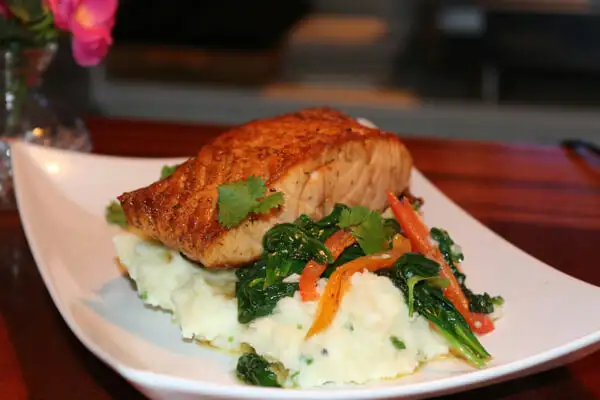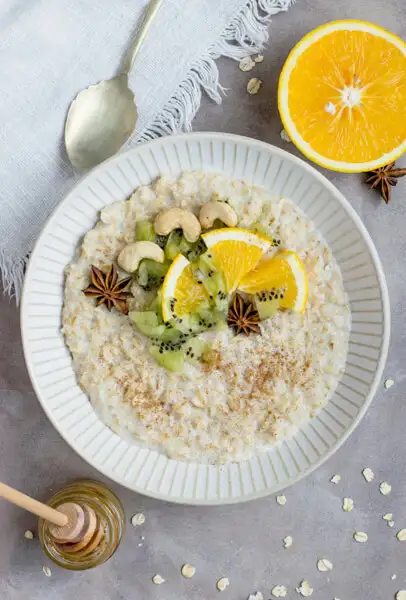Last updated on May 15, 2024
If you’re worried about not getting enough to eat while travelling in Ireland, I can already reassure you: Irish cuisine is delicious, rich and the plate is usually pretty full!
Page Contents (click line to jump the text)

You will be full in Ireland
If you’re planning a diet, it’s better to do it before your trip to Ireland, because Ireland is not a country where people spend the whole evening munching on a lettuce leaf!
And it’s best to go on another diet after your trip to Ireland….No, it’s not that bad!
In Ireland you will find a colourful mix of traditional Irish dishes, English dishes and international cuisine. Ireland was not a wealthy country for a long time. Traditional Irish cuisine was therefore simple but hearty and, above all, meant to fill you up and keep you warm.
I speak from experience when it comes to Irish food, as my family and I live in Ireland (we come from Germany). In the summer, we run our motorbike rental business south of Dublin (www.easycruiser.tours) and also offer beautiful guest rooms.
But let’s move on to Irish cuisine:
Typical ingredients of Irish cuisine
In addition to the best beef and lamb, poultry, eggs and butter, the finest Atlantic fish and seafood are among the most important ingredients in Irish cuisine. Furthermore, potatoes, oats and various vegetables, which thrive particularly well in Ireland. These include different types of cabbage, various types of turnips, celery, leeks and onions.
On the Emerald Isle there is lush green pastureland almost all year round. Temperatures in winter usually remain above zero degrees (Celsius), frost is rare and then usually not prolonged. Due to the mild climate, sheep usually live outside all year round and cattle often all year round, but at least 9 months of the year. These animals live much healthier lives and move around much more than their counterparts in German intensive stall farming.
As a result, Irish farmers not only produce the best milk and butter, but also the finest meat! Beef therefore tastes much better in Ireland than in Germany! There are also millions of sheep in Ireland and lamb has been part of Irish cuisine for centuries – you should also try it!
With the exception of oats, not much grain grows on the island, but lots of vegetables. In particular, carrots, yellow turnips, various types of cabbage, leeks, celery, peas and beans can be found in many Irish dishes.
The potato has been a staple of Irish cuisine for centuries and can still be found in all varieties in many dishes – and in large quantities!
In Ireland, the sea is never far away in any direction. The clear currents of the Atlantic are home to many species of fish and sea creatures. And so the best salmon, the finest mussels and oysters, crabs and langoustines and sea fish such as cod and hake are regularly on the menu of the islanders.

So, those are the essential ingredients of Irish cuisine – and what will you be eating on your trip?
Typical dishes on your trip to Ireland
1) Porridge
2) Full Irish Breakfast
3) Scones and soda bread
4) Soup and Sandwich
5) Cesar Salad with/without chicken
6) Seafood Chowder
7) Bangers and Mash
8) Mussels and Oysters
9) Various dishes with salmon
10) Fish and chips
11) Shepherds Pie and Cottage Pie
12) Irish stew with lamb or beef
13) Bacon and cabbage
14) Roast Beef
15) Steaks and burgers
16) Lamb Chops
17) Chicken Tikka Masala and various curries
18) Apple Crumble
19) Carrot cake
20) Cheesecake
21) Chocolate Cake and “Death by Chocolate”
# 1) Porridge
Porridge is a cooked oatmeal that is often flavoured with sultanas, berries or fruit. Many Irish people always have it for breakfast, as well as a cup of strong black tea. If that’s not enough, toast with jam is also served, often with sweet and bitter orange marmalade.

# 2) Full Irish breakfast
This cooked and fried meal is more of a (late) breakfast for the weekend and is also often eaten for lunch. In addition to fried eggs and bacon, it includes pork sausages, white beans in tomato sauce and fried mushrooms, as well as fried slices of black and white pudding. However, this is not a sweet pudding (as in German), but is best translated as liver sausage and black pudding. If you find this too heavy for breakfast, you can also order “slimmer” versions with less sausage.
# 3) Scones and soda bread
Soda bread is a traditional Irish bread that is baked with baking soda instead of yeast. It is widespread in Ireland, as is toast.
Scones are about the size of a fist and are often eaten with tea, but also for breakfast. The dough is very firm and the flavour is only slightly sweet. The Irish like to serve them with whipped cream and sweet jams.
# 4) Soup and sandwich
A real insider tip for the motorbike trip: almost every pub in Ireland also offers lunch and soup and sandwich is a great meal that fills you up but is not too heavy, so that you can easily ride your motorbike for the next few hours afterwards. The soup is usually a hearty vegetable soup and the sandwich usually has a generous topping. Sometimes there are also crisps or chips.
# 5) Cesar Salad
Another insider tip for a meal that is not too heavy: the internationally renowned Cesar Salad with or without chicken is often served with soda bread.
# 6) Seafood chowder
Another motorcyclist’s secret tip for the lunch break: Seafood chowder is a bowl of hearty, creamy fish soup. Fish and seafood are cooked with vegetables such as potato, celery, carrot and leek in a thick stock. The result is a hearty soup with a not-too-strong fish flavour and is served with soda bread.
# 7) Bangers and mash:
The Irish love mash – this is a hearty mashed potato, perhaps comparable to mashed potatoes. Bangers are sausages that are often made from beef or lamb. The whole thing swims in a strong gravy with onions and tastes extremely good.

# 8) Mussels and oysters
The clear waters of the Atlantic provide Ireland with the best fish and seafood. In fact, the quality of the mussels and oysters is so excellent that there is a big food festival in Galway specifically for them, the Galway International Oyster & Seafood Festival. Incidentally, there are also many great crab and langoustine dishes.
# 9) Various dishes with salmon
The salmon from Ireland’s west coast is also excellent and is offered almost everywhere in many variations: boiled, fried, steamed or smoked – no matter in which form, it always tastes really good.
# 10) Fish and chips
Fish and chips have probably been adopted from England. They are everywhere. Cod (cod), hake (hake) and haddock (haddock) are the most common varieties of fish and chips. However, these fish are also prepared as fillets in different variations, i.e. without the breading and then served with different vegetables and potato variations.

# 11) Shepherd’s pie and cottage pie
These traditional Irish dishes usually consist of two layers and are prepared in the oven. The bottom layer is a mixture of minced meat and vegetables. On top is a layer of creamy mashed potato (with butter and milk). The whole thing can be topped with cheese. Lamb is used for the shepherd’s pie and beef for the cottage pie.
# 12) Irish stew with lamb or beef
Irish stew is the Irish national dish. It is a hearty stew with pieces of meat, chunks of potato, carrots and other vegetables. Originally, mutton was used for this, but today it is usually lamb or beef, or a mixture of both types of meat.
# 13) Bacon and cabbage:
This is still a classic in Ireland: a large boiled ham (comparable to smoked pork in Germany), with white cabbage and a light-coloured sauce. Does it come with potatoes? But yes – always in Ireland!
# 14) Roast beef
This does not refer to cold slices of meat, but a large hot evening meal with roast beef with gravy, fried or deep-fried pieces of potato, cabbage and often also Yorkshire pudding, a kind of pastry.

# 15) Steaks and burgers
Here it gets international: Irish beef is really fantastic and gives every burger or steak a special flavour!
# 16) Lamb chops
Lamb has a long tradition in Ireland – and you probably won’t find it more tender and flavourful anywhere else.
# 17) Chicken tikka masala and curry in different variations
Indian cuisine came to Ireland via England and so you can also find Indian-inspired curries of all kinds in Irish pubs – and yes, the Irish can also eat spicy food!
18) Apple crumble
Now we come to the dessert: Apple crumble is not comparable to apple pie: The dough is softer and the apple is more like apple compote. The whole thing is therefore quite runny and is usually served warm, often with vanilla sauce or cream.
19) Carrot cake
A delicious firm carrot cake. Don’t talk too much – just try it!

20) Cheese Cake
Also a very tasty dessert. Much softer and creamier in consistency than German cheesecake.
21) Chocolate Cake and “Death by Cocolate”
The Irish have really perfected and “maxed out” the chocolate cake: chocolate cake is often served with ice cream or whipped cream, possibly also with a chocolate sauce.
In “death-by-chocolate”, the slightly warmed chocolate cake has a liquid chocolate centre inside, is topped with chocolate sauce and served with whipped cream and ice cream!!!
We have to stop at this point, because after “Death-by-Chocolate” there really is no more….!
Irish cuisine – tradition and modernity
Just 20 years ago, Irish cuisine was hearty, simple and traditional – hearty home cooking made from local ingredients. Nowadays, you can find international cuisine of all kinds all over the island, especially in the larger cities: Asian, Mediterranean, fine and upmarket cuisine can be found in the cities in particular.
But of course the big fast food chains and many small take-aways are also represented everywhere. Today you will find a colourful mix of Irish, British, Asian, American and continental European influences in Irish cuisine.
If you arrive at your hotel or B&B exhausted, dehydrated and hypoglycaemic after a long day on the motorbike, you will often search in vain for a restaurant – and usually find the longed-for salvation in a pub. Pub food is often far better than you might expect, and pubs often serve really good food. Sometimes you will find two areas, the pub with pub food on one side and a cosy restaurant in the next room.

Food Festivals in Ireland
The Irish are a sociable people and they love to party. And so there are all kinds of festivals to experience on the Emerald Isle throughout the summer: Art, literature and theatre festivals, music festivals, heritage and agricultural shows and food festivals.
The latter often last several days and if you have the opportunity to stop by a food festival on your motorbike tour, then you should definitely plan some time for it. There’s great fun, music and the finest dishes and culinary specialities Ireland has to offer:
Important Irish food festivals:
Connemara Shellfish Festival in Tully Cross
West Waterford Food Festival (https://www.westwaterfordfestivaloffood.com/)
August: Enniscorthy Rockin`Food Festival (https://www.rockinfoodfestival.ie/)
September: Galway International Oyster and Seafood Festival (https://www.galwayoysterfestival.com/)
Dingle Food Festival (https://www.dinglefood.com/)
Conclusion
If you’re on a diet, Ireland doesn’t have it easy. Vegetarians and vegans also have to search a little harder for suitable meals here than in the Mediterranean, for example.
Everyone else will find many hearty and delicious dishes in the Irish pubs and restaurants that will recharge the body with energy after a long day on the motorbike – and there is also Irish music and Irish beer for the soul! But that’s another story….
More interesting articles for you
IRELAND TRAVEL FAQ
WHY GO TO IRELAND OF ALL PLACES? – 9 GOOD REASONS FOR A TRIP TO IRELAND
15 TIPS FOR BOOKING ACCOMMODATION IN IRELAND
ECO-TOURISM AND SUSTAINABLE TRAVEL – DISCOVER THE GREEN ISLAND SUSTAINABLY AND WITH CARE
Image credit cover picture: Irish fish dish, photo: Patrick Browne on Unsplash.
